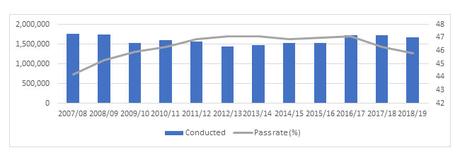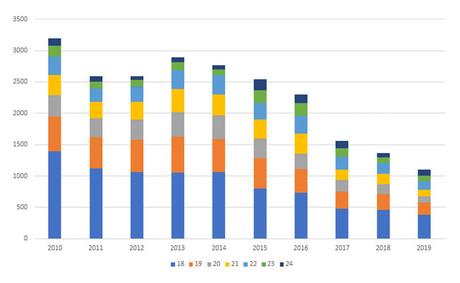Taking a driving test is worthy of being regarded as a milestone in life, made even better when you pass said test first time. But as of 2019, the success of learner drivers taking their test hit its lowest recorded figure since the end of 2010. While over the duration of the past decade the pass rate remained consistent, it began to drop at the start of 2017, as alterations to the test left many learners dismayed. With this in mind, could more young people feel prevented from taking on the roads, leading to a lessened overall skill set? Let’s take a look.
2007: The end of the road to freedom
Between the period 2007-2009, 822,489 ‘L’ plates were torn up in the UK as the pass rates soared, but this marked the beginning of something close to a plateau for learners as the pass rate took a drop and didn’t increase again until 2016. At this time of new driver success, the practical test bore little resemblance to the examination that drivers sit nowadays. The test included a reverse parking manoeuvre, and had only just began to include the compulsory ‘show me tell me’ questions. The all-important theory test had only just rolled out the hazard perception element, with the amount of questions increasing from 35 to 50 in 2007, adjusting the overall UK pass rate to 43%.
For the driving test itself, the 2007 adjustments were the first significant changes that affected the actual vehicle and the driver requirements since 1999, when the Highway Code was last revised, as well as extending the length of the test and randomising the emergency stop maneuver. The changes appear to have taken their toll though, causing the overall pass rate between 2008-2011 to sit at an average of 46.1%, increasing steadily as drivers geared up to meet the new requirements.
Stalled by 2017
The next changes to be made to the UK driving test were rolled out onto the roads in 2017, and they certainly caused a stir amongst learners. The changes included the omittance of the turn in the road and reverse around the corner manoeuvres, to the relief of many future drivers. New additions included a longer 20 minute period of independent driving, two extra show me tell me questions and a new reversing maneuver — drivers are asked to pull over on the right hand side of the road, then reverse for the length of two cars and then proceed to rejoin traffic. The test passes faced the resultant dip:

A distinct fall in successful learners ensued as the 2017/18 period results showed, and this continued to drop into 2018/19 — with a 6.6% drop in passes. The number of tests taken also fell, by a noticeable 3.9%, suggesting that drivers were reluctant to book their slot.
This becomes more evident in the results of both men and women, but who felt the impact of these new driving requirements the most? Looking at the data, women remained persistent despite the tougher criteria, with just 2.2% less tests taken, whereas there was a 5.6% drop in the amount of men taking their test. However, while more women took their test during the period 2016-2019, fewer of them were passing — with the female pass rate dropping by 5.6% and male by only 1%.
A new generation takes the wheel
Changes didn’t just happen to the driving test itself though, as those who are learning have also changed a lot in terms of the demographic. As generation z come of driving age, they’re shifting both the numbers of tests taken and the successful proportion.

As shown, progressively less 18-year olds have registered to drive, and their share of the age bracket has dwindled noticeably since 2010. Further up the bracket, 20-year olds have also experienced a steady fall in vehicle registrations, and fewer 24-year olds are registering vehicles than ever before.
Insuring and passing your test is one thing though, actually having a car to enjoy your newfound freedom is a whole other challenge in itself. For young drivers, having a car was once the ultimate luxury, and there was certainly a heightened status to having the key to freedom at your fingertips. However, for a variety of reasons generation zeds have turned the once popular tradition on its head, with a huge 54% drop in the amount of those who own their own car over the period 2015-2019. The figure experienced a similar plummet for those who chose to get insured on their parent’s car, and the figure for 2019 is 70% less than the 2015 stat. This does suggest that overall, fewer young people are taking learner insurance policies out, and it aligns further with the fact that overall.

While less tests are taken with fewer passes than ever before, changes to the examiners’ criteria have been proven to wear off eventually. The figure for passes climbed back up from 2007 onwards, as when the previous low point of 45.3% in 2008/09 slowly crept up, people adjusted to what was required of them, so it could only be a matter of time before learners become accustomed to the new test — then comes more changes!
Driving tests are a necessity due to the responsibility that being behind the wheel entails, so learners of any age should be prepared to demonstrate a sense of awareness which meets the examiners requirements.
Sources:
https://www.gov.uk/government/news/driving-test-changes-4-december-2017
https://www.2pass.co.uk/history-driving-test.htm
https://www.gov.uk/government/publications/car-show-me-tell-me-vehicle-safety-questions
